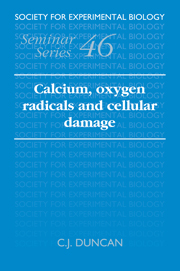Book contents
- Frontmatter
- Contents
- List of Contributors
- Preface
- 1 Are there common biochemical pathways in cell damage and cell death?
- 2 Free radicals in the pathogenesis of tissue damage
- 3 Calcium and signal transduction in oxidative cell damage
- 4 Regulation of neutrophil oxidant production
- 5 Reperfusion arrhythmias: role of oxidant stress
- 6 Biochemical pathways that lead to the release of cytosolic proteins in the perfused rat heart
- 7 Malignant hyperthermia: the roles of free radicals and calcium?
- 8 Free radicals, calcium and damage in dystrophic and normal skeletal muscle
- 9 Ultrastructural changes in mitochondria during rapid damage triggered by calcium
- 10 The importance of oxygen free radicals, iron and calcium in renal ischaemia
- 11 The Rubicon Hypothesis: a quantal framework for understanding the molecular pathway of cell activation and injury
- Index
9 - Ultrastructural changes in mitochondria during rapid damage triggered by calcium
Published online by Cambridge University Press: 18 January 2010
- Frontmatter
- Contents
- List of Contributors
- Preface
- 1 Are there common biochemical pathways in cell damage and cell death?
- 2 Free radicals in the pathogenesis of tissue damage
- 3 Calcium and signal transduction in oxidative cell damage
- 4 Regulation of neutrophil oxidant production
- 5 Reperfusion arrhythmias: role of oxidant stress
- 6 Biochemical pathways that lead to the release of cytosolic proteins in the perfused rat heart
- 7 Malignant hyperthermia: the roles of free radicals and calcium?
- 8 Free radicals, calcium and damage in dystrophic and normal skeletal muscle
- 9 Ultrastructural changes in mitochondria during rapid damage triggered by calcium
- 10 The importance of oxygen free radicals, iron and calcium in renal ischaemia
- 11 The Rubicon Hypothesis: a quantal framework for understanding the molecular pathway of cell activation and injury
- Index
Summary
Ultrastructural changes in muscle mitochondria during cell damage
During rapid cellular damage, the organelles frequently undergo major ultrastructural pathological changes which are shown most dramatically in the mitochondria. In particular, the mitochondria undergo apparent septation and subdivision, this phenomenon being most commonly seen in skeletal and cardiac muscle cells (Duncan, 1988). Are these ultrastructural changes in muscle mitochondria perhaps triggered by changes in the intracellular concentration of Ca2+ ([Ca2+]i) or by active oxygen radicals?
Lipid bodies, lipofuscin granules and myelin-like figures (or membrane whorls) are regarded as late-stage products of lysosomal digestion or as lysosome-derived elements in mammalian skeletal muscle; they occur rarely in human healthy muscle but are much more common in diseased muscle and in old age (Mastaglia & Walton, 1982; Dubowitz, 1985; Walton, 1988). Lipid droplets are present in many cells and are considered to lack a limiting membrane (Threadgold, 1976), but lipid bodies with a bounding membrane are clearly evident in the electronmicrographs of skeletal muscles of neonatal kittens (Tomanek, 1976), rats (Nag & Cheng, 1982) and dystrophic hamsters (Caulfield, 1966) as well as in ischaemic canine muscle (Stenger et al., 1962). Ultrastructural studies of mammalian skeletal muscle undergoing rapid cellular damage that is experimentally-induced in vitro, with a time-course of minutes (Duncan, 1988), show that lipid bodies develop quickly in association with the muscle mitochondria.
- Type
- Chapter
- Information
- Calcium, Oxygen Radicals and Cellular Damage , pp. 149 - 164Publisher: Cambridge University PressPrint publication year: 1991
- 2
- Cited by



